We Tested 8 Small Saucepans and Found Three We Love for Sauces, Browned Butter, and More
Dotdash Meredith and Yahoo Inc. may earn commission or revenue on some items through the links below.
Our top picks are from Made In, Duxtop, and All-Clad.
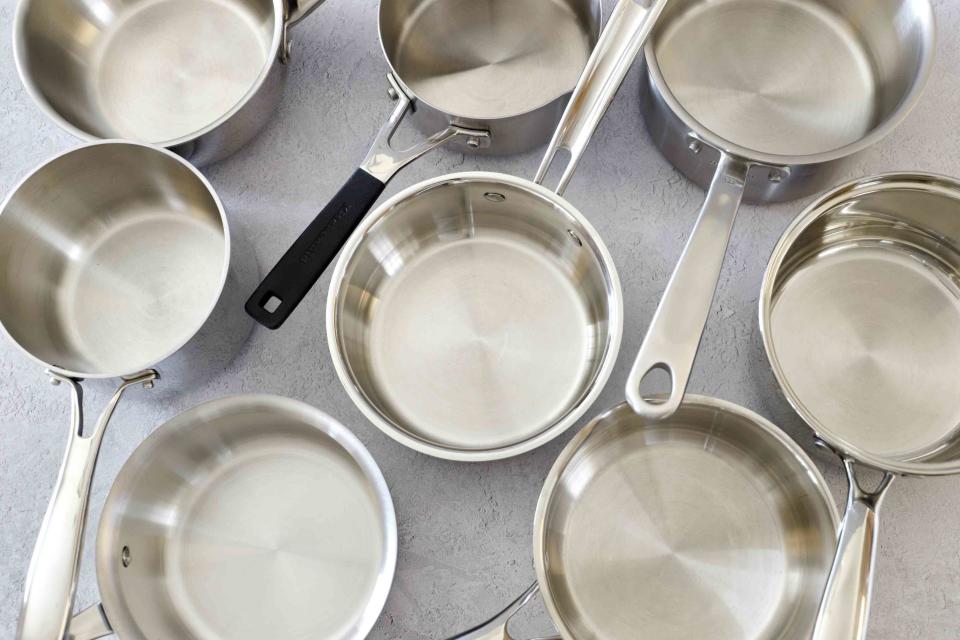
Serious Eats / Ashlee Redger
Straight to the Point
Our favorite small saucepan was the Made In 2 Quart Stainless Clad Saucepan. It was easy to clean, heated evenly, and had a concave handle that provided excellent maneuverability. For an affordable option, we liked the Duxtop 1.6 Quart Whole-Clad Tri-Ply Stainless Steel Saucepan, which was under $40 and had sloped corners, a stay-cool handle, and a rolled rim for smooth pouring. Our other top pick was the All-Clad D3 Stainless Everyday 1.5-Quart Saucepan, which was a mid-priced model that lived up to All-Clad’s great reputation.
In my two-person household, our little saucepan is the undisputed hero of our meal routine. It stays in constant rotation for boiling eggs, cooking rice and quinoa, and warming sauces. It’s my go-to for instant ramen and, since it has a two-quart capacity, it’s quick to boil water for a few servings of pasta, too (I’m a firm believer that you don’t need a huge vat to cook noodles).
I acknowledge that my inherited pot is nothing special—but it doesn’t have to be. While working on this review, I found that even the most basic saucepans can be Jacks-of-all-trades, although a few thoughtful features can turn them into masterful kitchen tools. To find the best ones, I looked at eight 1- to 2-quart saucepans, priced from $25 to $129. Since we don’t usually recommend nonstick cookware, all were made from versatile and durable stainless steel. The winning small saucepans were easy to maneuver and quick to clean; plus they heated evenly and poured smoothly without dribbling down their sides.
The Winners, at a Glance
The Best Overall Small Saucepan: Made In Stainless Clad Saucepan

The thoughtful design of the Made In saucepan made it a steadfast kitchen companion. It had tall sides that minimized boilovers and it's fully clad with five layers of aluminum and steel so heat could evenly distribute around the pot. The hollow handle stayed cool during cooking and had an indentation running up the center, which provided secure leverage while maneuvering the pot. Its rolled rim also made pouring a cinch.
The Best Budget Small Saucepan: Duxtop 1.6 Quart Whole-Clad Tri-Ply Stainless Steel Saucepan with Lid

This model was the most saucier-like of the bunch. Its smooth, sloped corners were easy to access with both a whisk and sponge. Like the Made In saucepan, it was fully clad (with three layers instead of five) and had a rolled rim for pouring.
The Best Small Saucepan from a Tried-and-True Brand: All-Clad D3 Stainless 1.5-Quart Saucepan

We liked the 3-quart D3 model in our full-size saucepans review, and this half-sized version proved itself just as functional. It possessed all the winning qualities: a contoured handle for grip, a drip-free rim for smooth pouring, and three layers of cladding for even heat.
The Tests
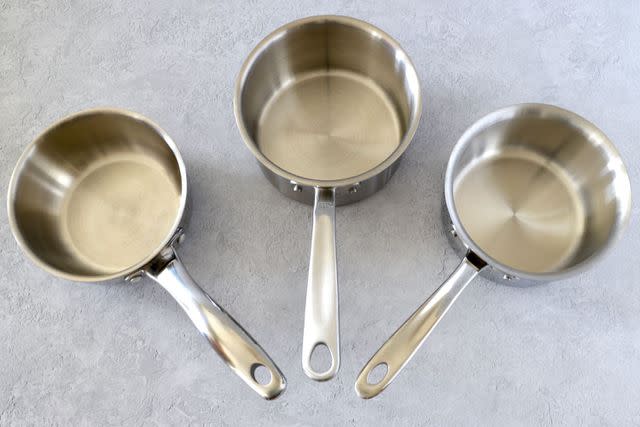
Serious Eats / Ashlee Redger
Boiling Water Test (Part 1): I put two cups of room-temperature water in each pan and brought it to a boil (uncovered) over medium-high heat. I tracked how long it took to boil, if the handle stayed cool and was comfortable to hold, and how easy it was to pour the water out afterward.
Boiling Water Test (Part 2): I repeated the boiling test with each saucepan, covering it with a lid (if it came with one). Again, I timed how long it took to boil and noted if the lid became hot or allowed excess steam to escape.
Brown Butter Test: To test how each saucepan performed over gentle heat, I browned four tablespoons of butter over medium-low heat and monitored how evenly it cooked. I also noted if the pans were comfortable to move and pour.
Hot Cocoa Test: I used each pan to simmer a cup of milk, then whisked in powdered hot cocoa mix. I observed whether my whisk could reach into the corners to prevent milk from scalding there, then poured the cocoa into a small mug to test how accurately the pans poured. I marked them down if they dribbled or dripped while pouring.
Cleaning and Usability Tests: After each test, I hand-washed and dried the saucepans to evaluate how straightforward they were to clean and if anything got stuck in their rivets, rims, or lids. I also assessed each pot for how comfortable it was to hold and maneuver, and if the handle became hot to touch.
What We Learned
Cladding Styles Varied
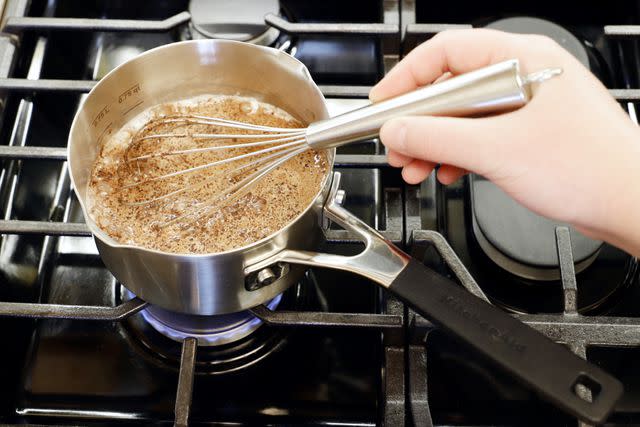
Serious Eats / Ashlee Redger
All of the saucepans I tested were at least partially clad, meaning they were made with layers of metals that had been stacked and bonded together. Stainless steel is great for cookware because it’s resistant to rust, it retains heat well, and it’s nonreactive (so you can cook acidic ingredients like tomatoes without damaging the pot or leaching metallic flavors). Aluminum, on the other hand, transfers heat quickly but can be much less durable. Clad pans are made with three to five layers with an aluminum (or, occasionally, copper) core sandwiched between stainless steel. This yields a versatile pan that heats quickly as well as evenly.
Read More: We Tested 9 Saucepans and Came Away with Three Favorites
Considering the saucepans had relatively small surface areas and capacities, tri-ply and five-ply saucepans seemed to perform about the same in terms of heating uniformity and responsiveness during testing. The All-Clad D3 Stainless Everyday Saucepan (which had three layers of cladding) heated about as evenly as Made In Stainless Clad Saucepan (which had five). All of the saucepans took around five to six minutes to boil uncovered, regardless of layers or cladding style.
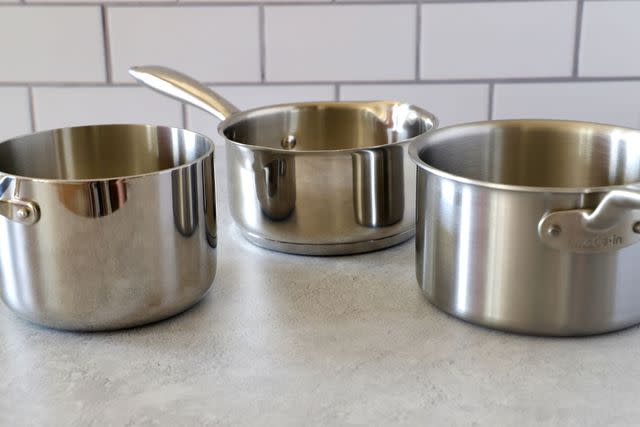
Serious Eats / Ashlee Redger
What did make some difference was the style of cladding. Fully-clad pots and pans are layered on the bottom as well as the sides for more even heat distribution, while capsule-bottom cookware has a clad base attached (leaving the side walls unclad). You can tell capsule-bottom pots from fully-clad ones because there is a visible seam running along the base where the disk is attached. Since their sides lacked extra layers to moderate the heat, butter browned faster around the edges of capsule-bottom models and needed to be stirred more often. While pouring from the Cook N Home Stainless Steel Saucepan, liquid would also spit and sputter as it came into contact with the hot upper edge of the pot. While not a deal-breaker, it made for messier pours compared to the fully-clad models.
Rim Design Was Important for Clean Pouring
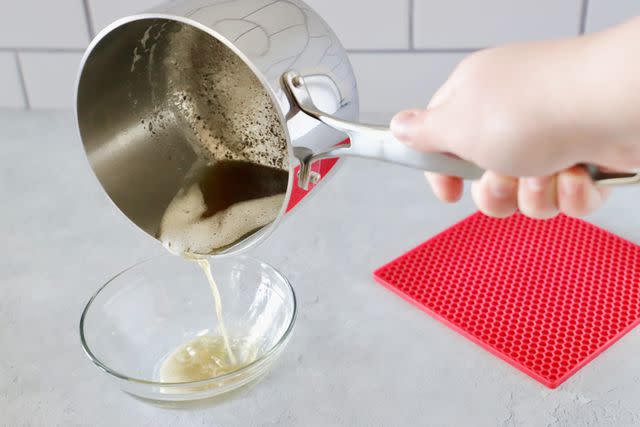
Serious Eats / Ashlee Redger
Being able to pour directly from the pot without having it drip or dribble was a surprisingly big factor in how convenient each saucepan was to use. The KitchenAid 1 Quart Saucepan and the AVACRAFT Stainless Steel 1.5 Quart Saucepan both had spouts to facilitate easy pouring, while the Cuisinart Multiclad Pro Triple-Ply 1.5-Quart Saucepan and the three winning saucepans all had rolled rims that allowed liquid to flow out smoothly.
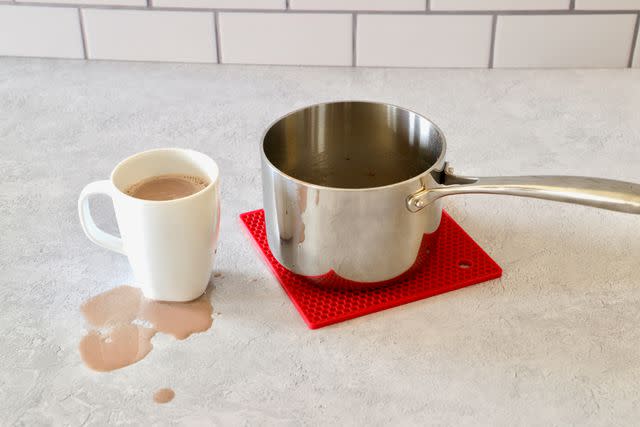
Serious Eats / Ashlee Redger
The Tramontina 1.5 Qt Tri-Ply Clad Stainless Steel, on the other hand, had a flat edge that allowed hot cocoa to dribble down its side, mostly missing the mug and spilling onto the countertop.
Sloped Sides Made Stirring (and Cleaning) Easy
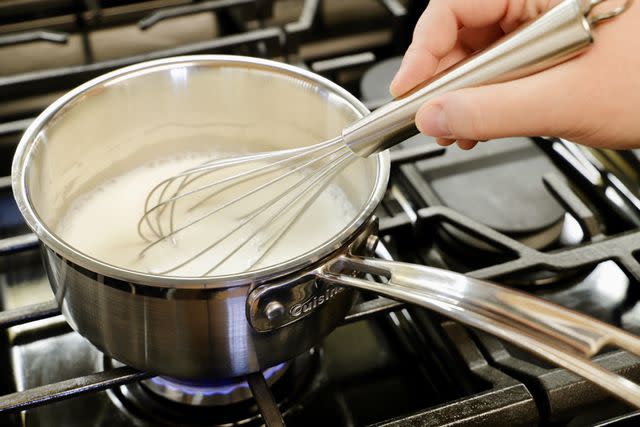
Serious Eats / Ashlee Redger
We love a saucier at Serious Eats. They aren’t all that different from a saucepan, except they’re often a tad more shallow and have sloped edges to make stirring easier. The Duxtop 1.6 Quart Whole-Clad Tri-Ply Stainless Steel Saucepan had saucier-like rounded corners that made whisking hot cocoa effortless and it was easy to wipe clean after. Comparatively, the Cook N Home and Tramontina models both had more traditional straight sides and steep corners which I had to angle the whisk to reach.
Concave Handles Offered Better Leverage
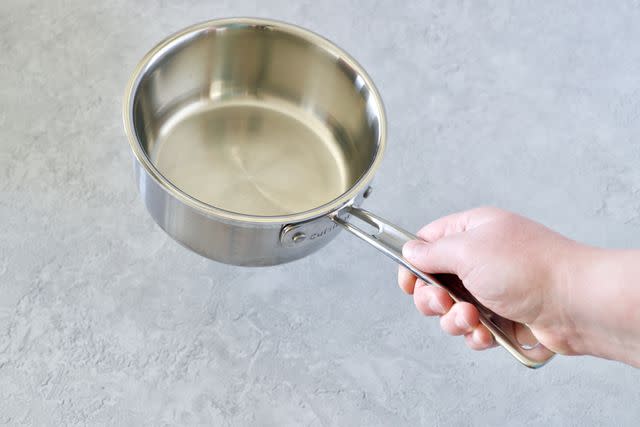
Serious Eats / Ashlee Redger
While curved pot handles felt comfortable in my hand at first, I quickly grew to appreciate the concave handles of the Made In, All-Clad, and Cuisinart models. The indentation that ran down the middle of their handles provided a resting spot for my thumb as well as a leverage point, especially when the pot was full. Rounder handles (like that of the Cook N Home and AVACRAFT pans) could get slippery when they were wet or oily, or if they were picked up with a soft kitchen towel. The KitchenAid’s handle was flat, but it had a silicone coating that kept it grippy and cool.
Simple Lids Were Better

Serious Eats / Ashlee Redger
While most of the saucepan’s handles could still be handled comfortably without a mitt after short cooking sessions, all of the lid handles got relatively hot by the time it took water to come up to a boil. The AVACRAFT saucepan was the only exception, as it had a silicone-coated lid handle. Unfortunately, the lid was not tight-fitting and it allowed steam to escape from the spouts when the water came up to a boil. Its lid also included strainer holes, which proved largely unusable. To let any water flow out, the lid had to be lifted up and back—which then allowed the pan’s contents to flow out underneath the rim of the lid, skipping the strainer holes altogether.
Both the AVACRAFT and the Cook N Home lids were made of glass, which allowed me to see the contents inside (until they steamed up and obscured the view). They also tended to be harder to clean. During its first wash, the Cook N Home saucepan got water stuck under the rivets and rim, where the glass attached to the metal. Lids that were fully made out of metal, like the one that came with the Made In saucepan, had fewer places for liquid and food to get stuck and were thus easier to clean.
The Criteria: What to Look for in a Small Saucepan
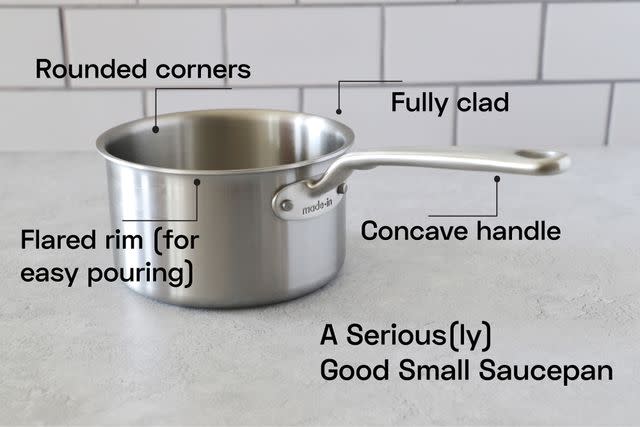
Serious Eats / Ashlee Redger
A great small saucepan should heat uniformly, pour smoothly, and be easy to clean. It should be fully clad with three or five layers for even heating. Rounded handles can get slippery, so a concave ridge offers leverage and maneuverability. The saucepan should have a rolled or tapered edge for even pouring, plus a simple metal lid that won’t hold onto food or moisture. Narrow corners can be hard to get to while stirring, so the saucepan should have rounded corners that can be easily accessed with the tines of a whisk.
The Best Overall Small Saucepan: Made In Stainless Clad Saucepan

What we liked: This handsome model not only looked high-quality but felt it, too. Its five-ply cladding heated evenly, and its tall sides helped prevent boil-overs. The handle stayed cool enough to touch, plus there was an indentation down the center where I could grip it with my thumb. This made the pan feel secure in my hand while moving as well as pouring, which it did cleanly and accurately thanks to its rolled rim. Even though all of the models I tested were made with stainless steel, the polished interior of the Made In saucepan seemed almost nonstick. It had fewer milk solids stuck to the bottom after the browned butter test and less scalded milk after the hot cocoa test. What little did stick from cooking sponged off easily during handwashing.
What we didn’t like: This saucepan was the priciest of the lineup. It also had moderately steep corners, which required me to angle the tines of my whisk to stir into them.
Price at time of publish: $129.
Key Specs
Capacity: 2 quarts
Weight: 2 pounds, 6 ounces with lid; 1 pound, 13 ounces without lid
Type of cladding: Fully-clad
Layers of cladding: Five (stainless steel exterior layers, aluminum inner layers, and aluminum alloy core)
Lip-to-lip diameter: 7 inches
Base diameter: 5.75 inches
Depth: 3.75 inches
Handle length: 6.75 inches
Induction compatible: Yes
Oven-safe: Up to 800°F
Warranty: Made In’s warranty for stainless clad cookware covers any defects from manufacturing, but not changes in appearance or damage resulting from cleaning in the dishwasher, metal utensils, or normal wear and tear
Cleaning and care: Dishwasher-safe, but hand-washing is recommended; avoid using metal tools to prevent scratching
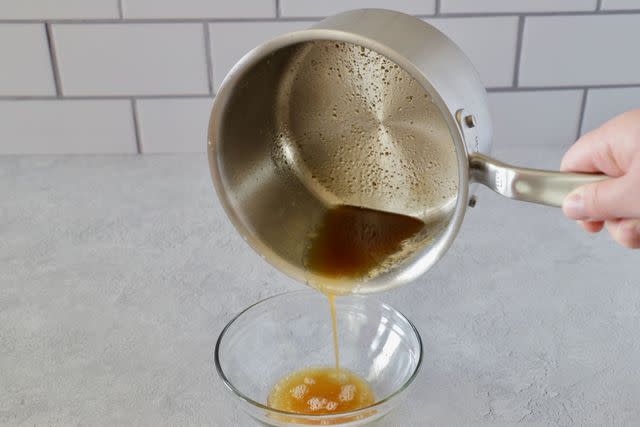
Serious Eats / Ashlee Redger
The Best Budget Small Saucepan: Duxtop 1.6 Quart Whole-Clad Tri-Ply Stainless Steel Saucepan with Lid

What we liked: This model had super curved corners that made it feel more like a saucier than a saucepan (which we love). It was easy to stir around it while cooking and to clean it up afterward. Like the Made In model, the Duxtop had a rolled rim that minimized dribbles and its handle stayed cool enough to handle after boiling water and browning butter.
What we didn’t like: The rounded handle felt almost bulbous and could get slippery if it got wet or oily.
Price at time of publish: $36.
Key Specs
Capacity: 1.6 quarts
Weight: 2 pounds, 4 ounces with lid; 1 pound, 11 ounces without lid
Type of cladding: Fully-clad
Layers of cladding: 3 (stainless steel exterior, aluminum core)
Lip-to-lip diameter: 6.75 inches
Base diameter: 5 inches
Depth: 3 inches
Handle length: 6.75 inches
Induction compatible: Yes
Oven-safe: Up to 500°F
Warranty: Duxtop’s limited lifetime warranty offers repair or replacement for products with defects related to material or workmanship; it does not cover minor imperfections, surface markings, or changes due to normal wear and tear
Cleaning and care: Dishwasher-safe, but handwashing is recommended; avoid using abrasive scrubbers (like steel wool) and caustic cleaners (like bleach or oven cleaner); Bar Keepers Friend is recommended for stubborn stains
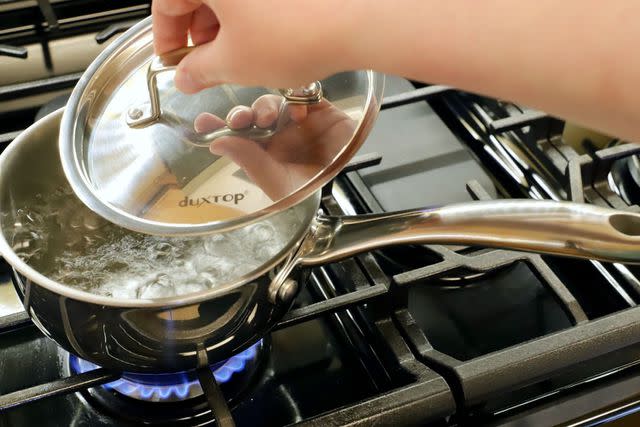
Serious Eats / Ashlee Redger
The Best Small Saucepan from a Tried-and-True Brand: All-Clad D3 Stainless 1.5-Quart Saucepan

What we liked: All-Clad is a titan in the cookware market, and its stainless products are known to last a lifetime. This sturdy pot had tri-ply cladding that heated uniformly every time. Like the Made In, the All-Clad saucepan had a concave handle that made it easy to maneuver and pour.
What we didn’t like: The All-Clad’s handle was a little narrower and less comfortable to hold than the Made In saucepan, plus it got hotter faster. Although it had a “drip-free rim” that worked well most of the time, liquid tended to dribble down the side if poured from slowly.
Price at time of publish: $100.
Key Specs
Capacity: 1.5 quarts
Weight: 2 pounds, 6 ounces with lid; 1 pound 13 ounces without lid
Type of cladding: Fully-clad
Layers of cladding: 3 (stainless steel exterior, aluminum core)
Lip-to-lip diameter: 6.88 inches
Base diameter: 5.5 inches
Depth: 3.5 inches
Handle length: 6.75 inches
Induction compatible: Yes
Oven-safe: Up to 600°F
Warranty: Per its limited lifetime warranty, All-Clad will repair or replace cookware with defects in material, construction, or workmanship for the lifetime of the product under normal use; it does not cover damage from improper use, normal wear and tear, scratches, or surface marks and discoloration
Cleaning and care: Hand-washing is recommended; baking soda or non-abrasive cleaners (like Bar Keepers Friend) can be used for other tough marks; avoid harsh detergents or cleaners as well as abrasive scouring pads.
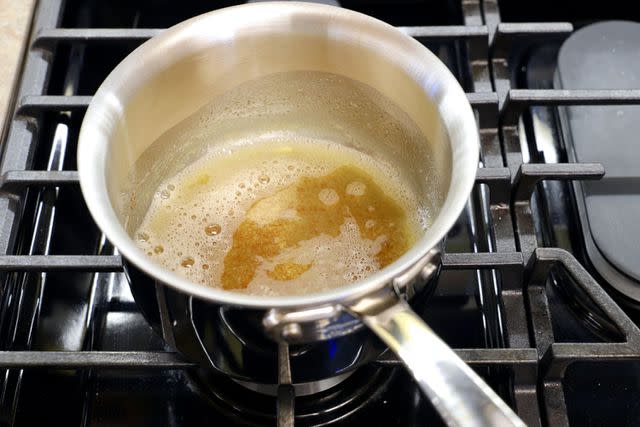
Serious Eats / Ashlee Redger
The Competition
Cuisinart Multiclad Pro Triple-Ply 1.5-Quart Saucepan with Cover: This model performed nearly as well as the winning models, and shared many of their best characteristics: it had an indented handle that was easy to grasp, a tapered edge that poured cleanly, and full cladding that heated evenly. Unfortunately, it also shared some of the same drawbacks as its 3-quart counterpart, which we tested in our best saucepan review. Namely, it had steep sides that were hard to stir into and a flat lid that held onto condensation rather than a curved one that would roll it back into the pan. Its thin handle also wasn’t the most comfortable to hold and got warm in the boiling tests. Still, we’d recommend this as an affordable backup if the Duxtop was unavailable.
AVACRAFT Stainless Steel 1.5 Quart Saucepan with Glass Lid: This model’s lid didn't fit tightly against the spouts on either side of the pot, which meant steam escaped even when the pot was covered. The lid also included strainer holes (to drain pasta, for example), but it had to be pulled back to allow water to flow out, which made a gap underneath the rim of the lid and rendered the strainers moot. The handle also got hot during cooking.
KitchenAid 1 Quart Saucepan with Pour Spouts: The KitchenAid saucepan performed acceptably, but it was the only model tested that did not come with a lid. Although it undoubtedly could melt a stick of butter and reheat soup, its short sides and small capacity make it ill-suited for many everyday tasks, like making rice.
Cook N Home 2-Quart Stainless Steel Saucepan with Lid: While it was affordable, the Cook N Home had an uncomfortably bulbous handle that got hot while cooking. It also had an inner rim that took extra time to clean when food and liquid got caught. Since the pot only had capsule-bottom cladding, the sides got unevenly hot and caused water to spit and sputter when pouring.
Tramontina 1.5 Qt Tri-Ply Clad Stainless Steel Covered Sauce Pan: The Tramontina was a handsome and uncomplicated saucepan, but it was missing a few key features: its straight rim caused liquid to dribble down the side while pouring and it had steep corners that were difficult to reach with a whisk.
FAQs
What size is a small saucepan?
Small saucepans usually have 1- to 2-quart capacities, while most standard saucepans can hold between three and four quarts. Smaller saucepans are great for cooking for one or two people, warming sauces, boiling eggs, and preparing rice or oatmeal.
Should a small saucepan have a lid?
A lid can help boil water fast, cook grains, and minimize evaporation when cooking soups or sauces. A universal lid is a good option for saucepans that come without one.
What is a very small saucepan called?
Mini saucepans are often called milk or butter warmers and have a capacity of a quart or less. In addition to heating butter and milk, they are good for melting chocolate, reheating coffee or tea, and making spiced oils like tadka.
Read More: We Tested 18 Cookware Sets–Here Are 3 We Think Are Actually Worth Buying

